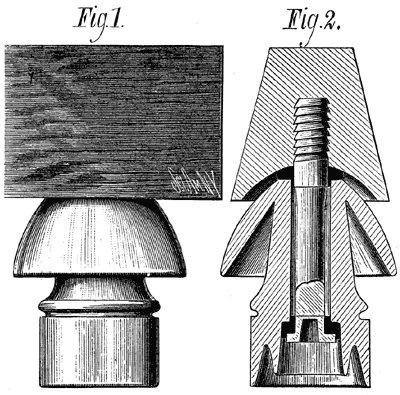[Trade Journal]
Publication: Scientific American
New York, NY, United States
vol. 43, no. 25, p. 387, col. 3
NEW TELEGRAPH INSULATOR.
The insulator represented in the annexed engraving was originally designed to meet the requirements of South American telegraph service, but it is equally well adapted to lines in other places. The main idea is to avoid breakage from expansion and contraction in a climate subject to sudden changes of temperature, and to avoid the mischief occasioned by a well known South American bird, the "hornero," by building nests of mud on the brackets and insulators. With this insulator these nests cannot cause a weather contact or earth; on the contrary, the nest rather improves the insulation. The sectional view, Fig 2, shows the construction of the insulator and the manner of fastening it to the cross arm or bracket. A rubber ring is placed between the upper end of the porcelain insulator and the cross arm, and another similar ring is placed between the head of the suspending screw and the bottom of the insulator.
 |
| Improved Telegraph Insulator. |
It will be noticed that with this construction the insulator cannot be broken by the contraction of the screw or by the swelling of the cross-piece. This insulator can be used on an iron bracket and in connection with either iron or wooden posts, and is in every way more secure than the insulators in common use. The first cost of these insulators compares favorably with the cheapest in market, while it is less liable to breakage, lasts longer, and gives better results. It has been patented in this country and in Europe.
Further information maybe obtained by addressing Mr. J. H. Bloomfield, Concordia, Entre Reos, Argentine Republic, South America.
